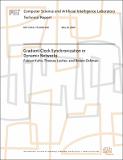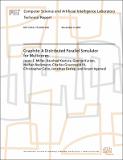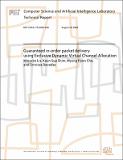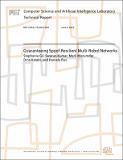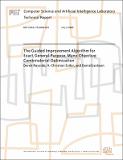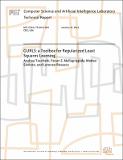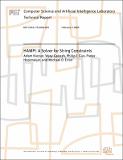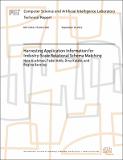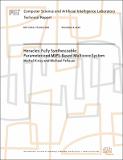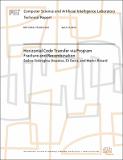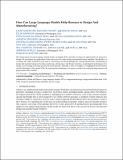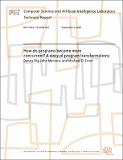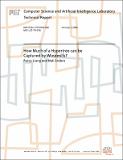Browsing CSAIL Technical Reports (July 1, 2003 - present) by Title
Now showing items 308-327 of 775
-
Gesture in Automatic Discourse Processing
(2008-05-07)Computers cannot fully understand spoken language without access to the wide range of modalities that accompany speech. This thesis addresses the particularly expressive modality of hand gesture, and focuses on building ... -
Gradient Clock Synchronization in Dynamic Networks
(2009-05-29)Over the last years, large-scale decentralized computer networks such as peer-to-peer and mobile ad hoc networks have become increasingly prevalent. The topologies of many of these networks are often highly dynamic. This ... -
Graphite: A Distributed Parallel Simulator for Multicores
(2009-11-09)This paper introduces the open-source Graphite distributed parallel multicore simulator infrastructure. Graphite is designed from the ground up for exploration of future multicore processors containing dozens, hundreds, ... -
Guaranteed in-order packet delivery using Exclusive Dynamic Virtual Channel Allocation
(2009-08-18)In-order packet delivery, a critical abstraction for many higher-level protocols, can severely limit the performance potential in low-latency networks (common, for example, in network-on-chip designs with many cores). While ... -
Guaranteeing Spoof-Resilient Multi-Robot Networks
(July 2015)Multi-robot networks use wireless communication to provide wide-ranging services such as aerial surveillance and unmanned delivery. However, effective coordination between multiple robots requires trust, making them ... -
The Guided Improvement Algorithm for Exact, General-Purpose, Many-Objective Combinatorial Optimization
(2009-07-03)This paper presents a new general-purpose algorithm for exact solving of combinatorial many-objective optimization problems. We call this new algorithm the guided improvement algorithm. The algorithm is implemented on top ... -
GURLS: a Toolbox for Regularized Least Squares Learning
(MIT CSAIL, 2012-01-31)We present GURLS, a toolbox for supervised learning based on the regularized least squares algorithm. The toolbox takes advantage of all the favorable properties of least squares and is tailored to deal in particular with ... -
HAMPI: A Solver for String Constraints
(2009-02-04)Many automatic testing, analysis, and verification techniques for programs can be effectively reduced to a constraint-generation phase followed by a constraint-solving phase. This separation of concerns often leads to more ... -
Harvesting Application Information for Industry-Scale Relational Schema Matching
(2013-09-10)Consider the problem of migrating a company's CRM or ERP database from one application to another, or integrating two such databases as a result of a merger. This problem requires matching two large relational schemas with ... -
Heracles: Fully Synthesizable Parameterized MIPS-Based Multicore System
(2010-12-08)Heracles is an open-source complete multicore system written in Verilog. It is fully parameterized and can be reconfigured and synthesized into different topologies and sizes. Each processing node has a 7-stage pipeline, ... -
Hierarchical Dirichlet Process-Based Models For Discovery of Cross-species Mammalian Gene Expression
(2007-07-06)An important research problem in computational biology is theidentification of expression programs, sets of co-activatedgenes orchestrating physiological processes, and thecharacterization of the functional breadth of these ... -
A hierarchical model of peripheral vision
(2011-06-17)We present a peripheral vision model inspired by the cortical architecture discovered by Hubel and Wiesel. As with existing cortical models, this model contains alternating layers of simple cells, which employ tuning ... -
Hierarchical Task and Motion Planning in the Now
(2010-05-07)In this paper we outline an approach to the integration of task planning and motion planning that has the following key properties: It is aggressively hierarchical. It makes choices and commits to them in a top-down fashion ... -
High Spatial Resolution BRDFs with Metallic powders Using Wave Optics Analysis
(2013-04-24)This manuscript completes the analysis of our SIGGRAPH 2013 paper "Fabricating BRDFs at High Spatial Resolution Using Wave Optics" in which photolithography fabrication was used for manipulating reflectance effects. While ... -
Horizontal Code Transfer via Program Fracture and Recombination
(2015-04-14)We present a new horizontal code transfer technique, program fracture and recombination, for automatically replacing, deleting, and/or combining code from multiple applications. Benefits include automatic generation of new ... -
How do programs become more concurrent? A story of program transformations
(2008-09-05)For several decades, programmers have relied onMooreâ s Law to improve the performance of their softwareapplications. From now on, programmers need to programthe multi-cores if they want to deliver efficient code. Inthe ... -
How Much of a Hypertree can be Captured by Windmills?
(2005-01-03)Current approximation algorithms for maximum weight {\em hypertrees} find heavy {\em windmill farms}, and are based on the fact that a constant ratio (for constant width $k$) of the weight of a $k$-hypertree can be captured ... -
How People Re-find Information When the Web Changes
(2004-06-18)This paper investigates how people return to information in a dynamic information environment. For example, a person might want to return to Web content via a link encountered earlier on a Web page, only to learn that the ... -
How to Construct a Correct and Scalable iBGP Configuration
(2005-08-03)The Border Gateway Protocol (BGP), the current inter domain routing protocol in the Internet, has two modes of operation: eBGP (External BGP), used to exchange routing information between autonomous systems, and iBGP ...


